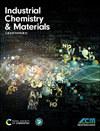应用于布废料独家化学回收的均相铁催化剂用乙醇解聚 PET
IF 11.9
引用次数: 0
摘要
用 FeCl3、FeBr3(1.0-5.0 mol%)对聚对苯二甲酸乙二醇酯(PET)与乙醇进行无酸、无碱解聚,只得到对苯二甲酸乙二醇酯(DET)和乙二醇(EG)(98->99 %,160-180 ºC),FeCl3 的催化剂活性表现更好。FeCl3 催化剂能使纺织废料中的 PET 独家进行选择性解聚,生成 DET(和回收的棉花废料),这有力地说明了在该催化反应中通过酯交换反应对纺织废料进行化学回收利用的可能性。本文章由计算机程序翻译,如有差异,请以英文原文为准。

Depolymerization of PET with ethanol by homogeneous iron catalysts applied for exclusive chemical recycling of cloth waste†
Acid-, base-free depolymerization of poly(ethylene terephthalate) (PET) with ethanol catalyzed by FeCl3, FeBr3 (1.0–5.0 mol%) gave diethyl terephthalate (DET) and ethylene glycol (EG) exclusively (98–99%, 160–180 °C), and FeCl3 showed better catalytic performance in terms of activity. The FeCl3 catalyst enabled exclusive, selective depolymerization of PET from textile waste to afford DET (and recovered cotton waste), strongly suggesting the possibility of chemical recycling of cloth waste by the transesterification in this catalysis.
Keywords: Depolymerization; PET; Chemical recycling; Textile waste management; Homogeneous catalyst.
求助全文
通过发布文献求助,成功后即可免费获取论文全文。
去求助
来源期刊

Industrial Chemistry & Materials
chemistry, chemical engineering, functional materials, energy, etc.-
自引率
0.00%
发文量
0
期刊介绍:
Industrial Chemistry & Materials (ICM) publishes significant innovative research and major technological breakthroughs in all aspects of industrial chemistry and materials, with a particular focus on the important innovation of low-carbon chemical industry, energy and functional materials. By bringing researchers, engineers, and policymakers into one place, research is inspired, challenges are solved and the applications of science and technology are accelerated.
The global editorial and advisory board members are valued experts in the community. With their support, the rigorous editorial practices and dissemination ensures your research is accessible and discoverable on a global scale.
Industrial Chemistry & Materials publishes:
● Communications
● Full papers
● Minireviews
● Reviews
● Perspectives
● Comments
 求助内容:
求助内容: 应助结果提醒方式:
应助结果提醒方式:


